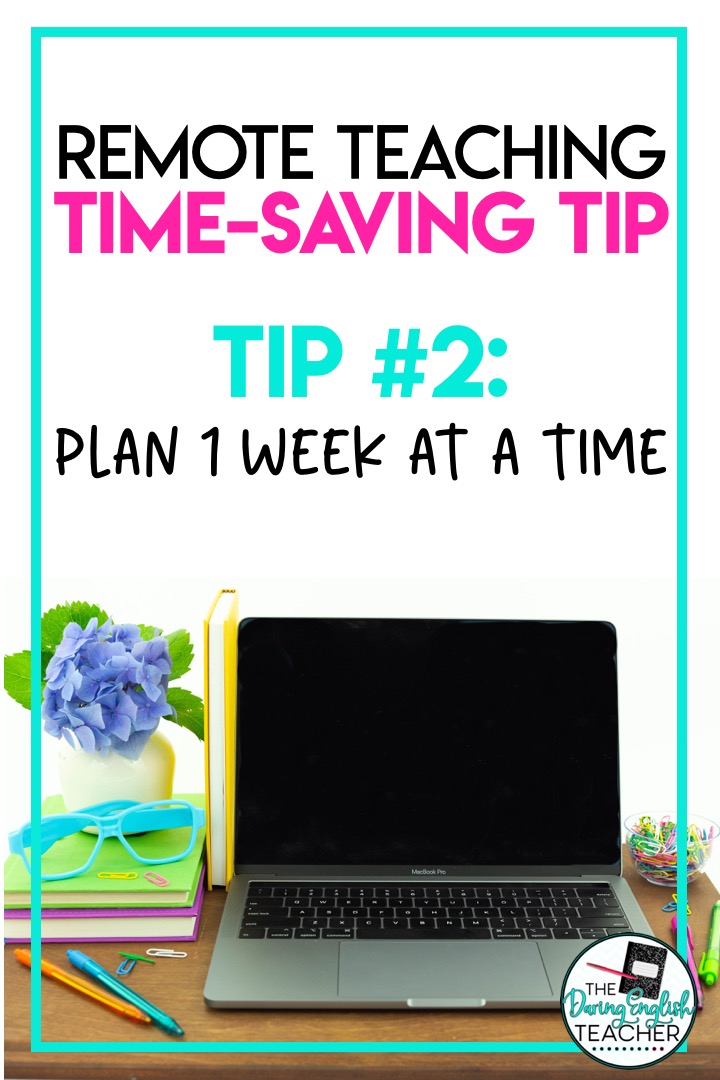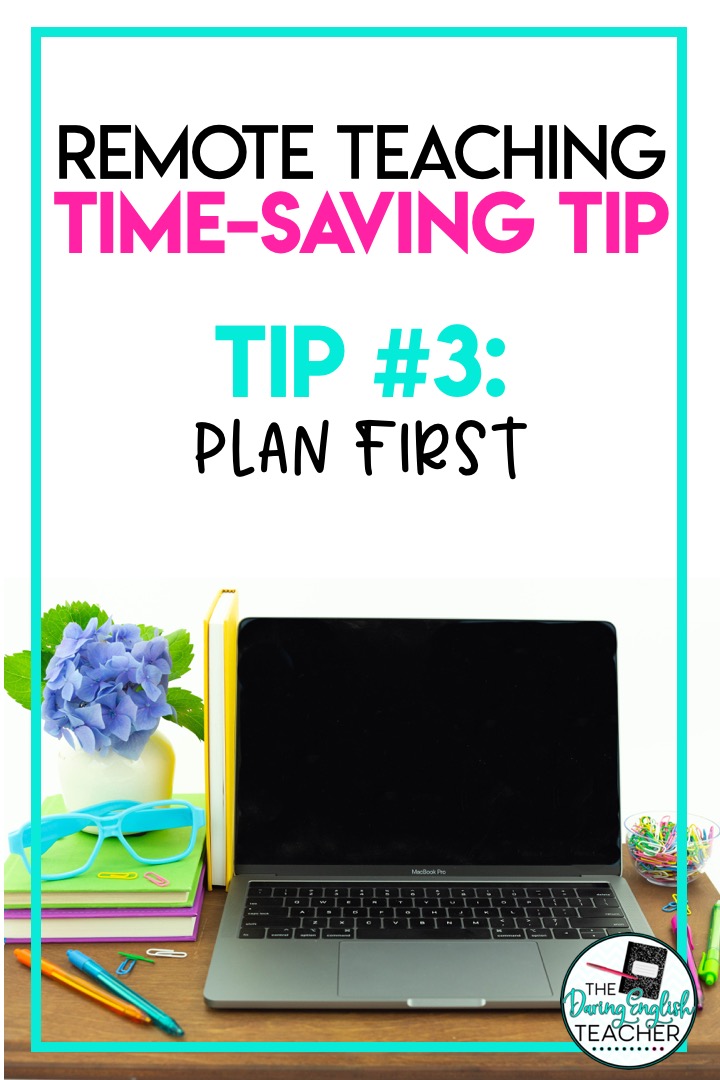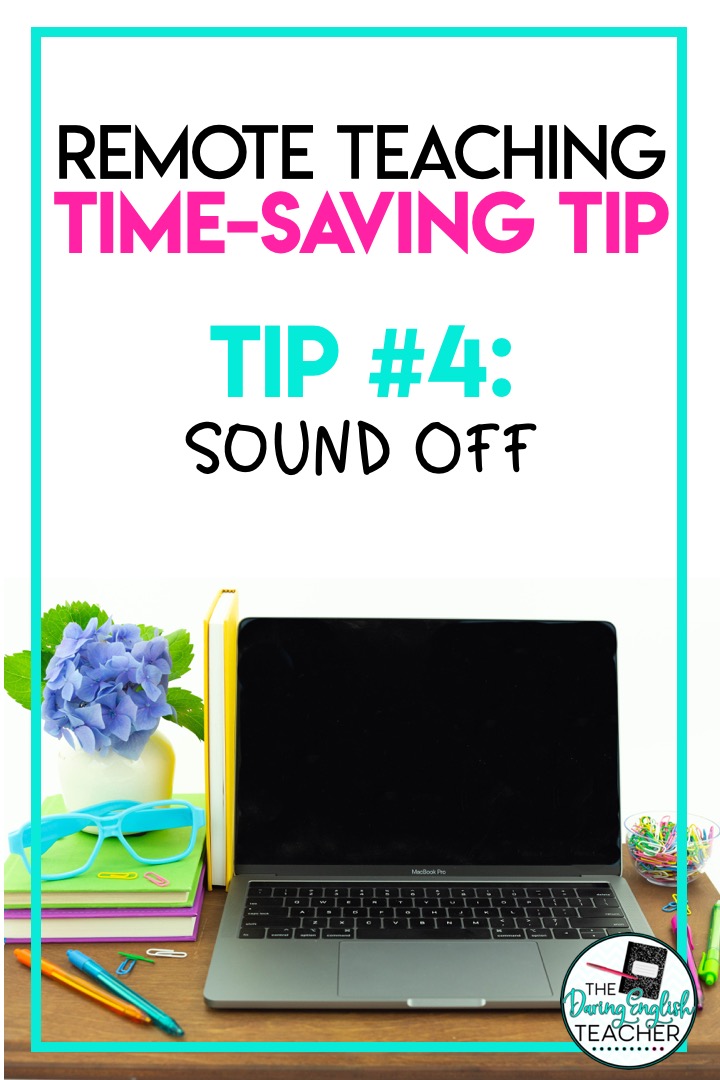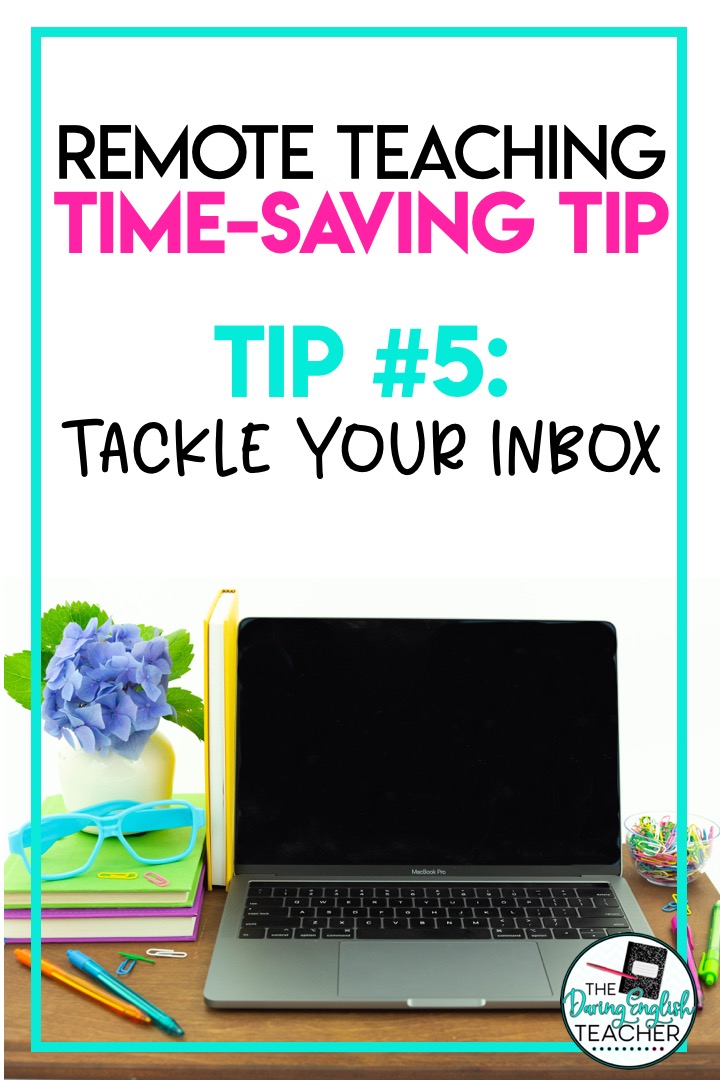After being back in the classroom teaching my students remotely for three weeks now, I am starting to feel like I am more in the groove. I don’t have distance teaching high school English mastered -I’m not even close, but I’m noticing that these remote teaching tips help me save some time and sanity.
Now, while every week, every day of distance teaching will be different this school year, these distance teaching time-saving tips might help those challenging days not seem so bad. And trust me, I had some bad days also. You can read about my first two weeks in this blog post.
Remote Teaching Tip: Batch Your Work
Batching your work is a productivity strategy that I use in my everyday life. Not only does batching my work keep me organized, but it helps me cross items off of my to-do list pretty quickly.
To batch your work when you are remote teaching, set aside a dedicated chunk of time to focus on just one task and do your very best to complete that task before getting distracted and moving on to something new.
Here are some distance teaching responsibilities that I batch to help save time: emails, grading assignments, and planning content. If I am going to go through my inbox and respond to student and parent emails, I will go through all of my new emails. By responding to all of my new emails at one time, I will make sure that I handle mass essential communication, and it will also help fewer emails fall through the cracks. If I am grading student work, I will grade one assignment for all of my sections before I move on to the next task.
Just yesterday, I decided that grading late student work was also going to be something I batch. I plan on grading all late student work on Mondays; that way, I don’t feel like I am always being pulled into old assignments to grade—the key to saving time while remote teaching is to try to avoid distractions.
Remote Teaching Tip: Plan One Week at a Time
When I plan my instruction during an ordinary school year, I typically focus on one week at a time. However, with the extra constraints of posting student work and content online, planning one week at a rime during remote teaching saves my sanity right now.
When I plan one week at a time, I make sure that I have my remote teaching lesson plans, student activities, and all of the student materials ready to go and loaded onto Canvas. I also like to look at my planning and make sure that each week includes a variety of activities. I want to make sure I include direct instruction, collaborative work, dedicated time for independent work, and multiple opportunities to check for understanding. By always being intentional about varying the structure of each week, students will stay more engaged.
I shared my first few weeks of back-to-school ideas and instruction for remote teaching high school English in this blog post.
Remote Teaching Tip: Plan First
And speaking of planning, plan first. I cannot emphasize that enough. Planning for a full week of instruction for the following week helps me keep my sanity. I’m the type of person, who if I have a looming task or deadline over my head, I can’t focus or dedicate 100 percent of my energy to a different task. For me, the same goes for planning.
Planning out my next week of content and instruction calms me down and keeps the stress of distance teaching slightly at bay. Once I have my next week planned, I can focus on grading assignments. I can focus on providing my students with meaningful feedback. I can concentrate on checking other items off of my to-do list.
To help teachers with their distance teaching secondary ELA planning, I put together this free secondary ELA digital curriculum map.
Remote Teaching Tip: Turn off Audible Email Notifications
This distance teaching tip goes hand-in-hand with batching work. Usually, when I receive an email through my district email, I hear that awful pinging noise. It jars me, and then immediately, I wonder what the email is about. I wonder if it is urgent. I wonder if a student needs help. I wonder, and then I lose all of my focus on what I was just doing. This wastes time. Even if it takes me just a couple of seconds to refocus and then resume what I was doing, time is gone.
The other day when I was planning out my next week of instruction, I turned my computer volume off. I didn’t hear a single email notification come through. I was able to dedicate 100 percent of my time and energy into planning the week for my high school English class and create all of the digital materials needs for the next week on Canvas. I was so productive. Had I not turned off the audible notification, I wouldn’t have been as productive.
As soon as I finished planning my week, as soon as I completed batching that work, I returned to my inbox and started batching a new task. And, when it comes to emails, I’ve also saved so much sanity teaching my students about email etiquette and how to write an email to a teacher.
Remote Teaching Tip: Keep Your Inbox Organized
Finally, the last time-saving tip I have for teachers teaching remotely or even in a hybrid setting is to keep your inbox organized. I cannot stress how important an organized inbox is. And trust me, my inbox is usually a hot mess. I typically purge emails only a few times a year, okay, maybe once, and I do the whole sort by name and type in a mailing list name and delta about 250 emails from the same sender at once. Not this year. I cannot afford to have a sloppy inbox this year. When it comes to remote teaching, it is imperative to have an organized inbox. Email is everything during remote teaching.
To help me keep my inbox organized (and I mean, I usually have a very Type B inbox), I created several important folders: SPED, tech tips, and save. All of my IEPs and communication regarding my SPED students get saved in a SPED folder. SPED communication is super important, and those emails need to be saved. Any tech tips I receive from my district that I might want to look at later also get saved into a tech tips folder. And finally, any other essential emails get saved into a save folder. It’s simple, but I only have those three folders. After I respond to all of my other emails, I delete them. Now, the inbox on my Canvas account is an entirely different story, though. Don’t worry, they all come through my email.
These aren’t the only time-saving tips for distance teaching teachers. However, these are five tips that are saving me both time and sanity right now. Everyone has different preferences and ways of accomplishing tasks, and if any of these tips help save you some time, that is great. With distance teaching and hybrid teaching, it’s one day and one week at a time. We’ve got this!









2 Comments
Batching sounds a lot like block scheduling. Is it the same? If so, I started doing that a few months ago, and I can’t believe how much better it makes me feel every day.
Hi! Thank you so much for these tips, in my case I´ve been facing difficulties to organize my time since the preparation of my everyday presentations takes me a lot of time :(. I´ve been doing full week planning, so, when I read about it here made me realize that I´m on the right track.